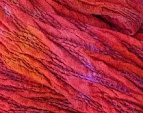
Dyeing warp threads for the next project, blankets for Pauanesia. You can see I have a very scientific take on making variegated warps. Threads tied to an old clothes drying rack picked up from the scrap metal bin at the tip. The thermometer came from a home brew supply shop and I couldn't be without it. The bundle of loom waste to match shades from a previous project and always my tea mug on hand. No, I don't use the jug to make my tea from, its solely for use with the dye. The dye pottles are Landscape brand which I rather like the shades of. I also use a lot a Jacquard acid dye.

And here are half the warps drying on the deck with the view out to Mayor (Tuhua) Island across the Pacific. The day before this was taken the ocean was a churning mess with huge waves crashing and churning wildly. The tuis love the banksia trees in the foreground, especially at this time of year when the flowers are out.
Today I'll be tying these warps on to the previous project and winding them on to the back beam.







